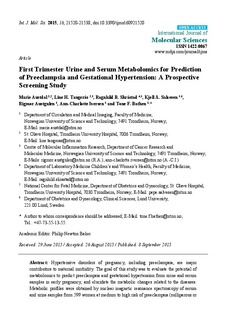| dc.contributor.author | Austdal, Marie | |
| dc.contributor.author | Tangerås, Line Haugstad | |
| dc.contributor.author | Skråstad, Ragnhild | |
| dc.contributor.author | Salvesen, Kjell Å | |
| dc.contributor.author | Austgulen, Rigmor | |
| dc.contributor.author | Iversen, Ann-Charlotte | |
| dc.contributor.author | Bathen, Tone Frost | |
| dc.date.accessioned | 2015-09-12T09:00:23Z | |
| dc.date.accessioned | 2015-11-05T11:50:19Z | |
| dc.date.available | 2015-09-12T09:00:23Z | |
| dc.date.available | 2015-11-05T11:50:19Z | |
| dc.date.issued | 2015 | |
| dc.identifier.citation | International Journal of Molecular Sciences 2015, 16(9):21520-21538 | nb_NO |
| dc.identifier.issn | 1422-0067 | |
| dc.identifier.uri | http://hdl.handle.net/11250/2359430 | |
| dc.description.abstract | Hypertensive disorders of pregnancy, including preeclampsia, are major
contributors to maternal morbidity. The goal of this study was to evaluate the potential of
metabolomics to predict preeclampsia and gestational hypertension from urine and serum
samples in early pregnancy, and elucidate the metabolic changes related to the diseases.
Metabolic profiles were obtained by nuclear magnetic resonance spectroscopy of serum
and urine samples from 599 women at medium to high risk of preeclampsia (nulliparous or previous preeclampsia/gestational hypertension). Preeclampsia developed in 26 (4.3%) and
gestational hypertension in 21 (3.5%) women. Multivariate analyses of the metabolic
profiles were performed to establish prediction models for the hypertensive disorders
individually and combined. Urinary metabolomic profiles predicted preeclampsia and
gestational hypertension at 51.3% and 40% sensitivity, respectively, at 10% false positive
rate, with hippurate as the most important metabolite for the prediction. Serum metabolomic
profiles predicted preeclampsia and gestational hypertension at 15% and 33% sensitivity,
respectively, with increased lipid levels and an atherogenic lipid profile as most important
for the prediction. Combining maternal characteristics with the urinary hippurate/creatinine
level improved the prediction rates of preeclampsia in a logistic regression model. The
study indicates a potential future role of clinical importance for metabolomic analysis of
urine in prediction of preeclampsia. | nb_NO |
| dc.language.iso | eng | nb_NO |
| dc.publisher | MDPI | nb_NO |
| dc.title | First Trimester Urine and Serum Metabolomics for Prediction of Preeclampsia and Gestational Hypertension: A Prospective Screening Study | nb_NO |
| dc.type | Journal article | nb_NO |
| dc.type | Peer reviewed | en_GB |
| dc.date.updated | 2015-09-12T09:00:23Z | |
| dc.source.volume | 16 | nb_NO |
| dc.source.journal | International Journal of Molecular Sciences | nb_NO |
| dc.source.issue | 9 | nb_NO |
| dc.identifier.doi | 10.3390/ijms160921520 | |
| dc.identifier.cristin | 1263676 | |
| dc.description.localcode | This is an open access article distributed under the Creative Commons Attribution License which permits unrestricted use, distribution, and reproduction in any medium, provided the original work is properly cited. | nb_NO |
